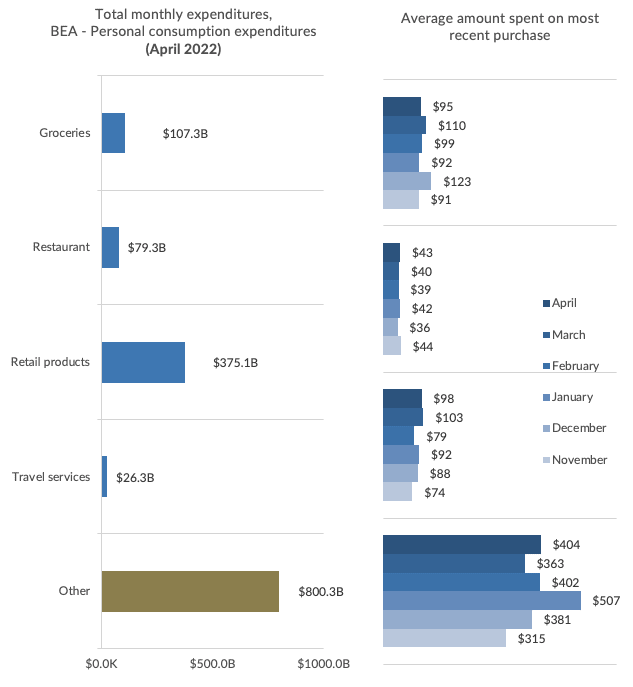Dwindling Cash, Mounting Headwinds Increase Pressure on Paycheck-to-Paycheck America

As that old Cole Porter song used to remind us: Things get “too hot not to cool down.”
The economy, as we all know, has its headwinds, with soaring inflation bumping up against consumers’ propensity and ability to keep spending.
And thus, there are a few things to keep in mind as we look toward the overall commerce landscape, and by extension, payments.
Retail Sales Slowing
The retail sales data just released show spending continues to be on the upswing — still positive yes, but growth is slowing.
Commerce Department data showed Tuesday (May 17) that retail spending rose at a seasonally adjusted pace of 0.9%, month over month.
Read more: US Retail Sales Rise 0.9% in April as Consumers Deal With Price Hikes
Now, 90 basis points may not sound like a lot, given the mid-single-digit percentage point gains we saw not all that long ago, and March was up 1.4% over February’s level. Inflation takes some credit here; we spend more to get the same amount of goods and services, or even a lesser amount. During that same month, inflation soared by 8.3%.
Drilling down into specific categories, per Commerce Department data, spending at restaurants and drinking places — i.e., going out to eat — was up 2%, while spending on groceries slipped 10 basis points. Spending at non-store retailers, loosely defined as eCommerce, was up 2.1%. These data points show what was top of mind and top of wallet not all that long ago.
But April is not now. Walmart’s earnings results Tuesday show that the number of transactions from U.S. consumers was relatively flat (even as same-store sales rose, a byproduct of inflation). Grocery sales grew by double digits at Sam’s Club, for example.
See more: Walmart Sees Demand Shift for Low-Priced Bacon and High-Ticket Game Consoles
Savings Cushions Are Tenuous
If we extrapolate Walmart’s results a bit, if transactions are flat and prices rise, our paychecks get stretched a bit thinner.
And as PYMNTS data have shown, the majority of consumers are living paycheck to paycheck — even relatively high earners who take home more than $100,000 annually. Generation Z consumers who live paycheck to paycheck and have issues paying their monthly bills report the lowest average savings at just $1,158, according to our continued findings. Millennials living paycheck to paycheck with issues paying their monthly bills report the highest savings, with an average of $3,731.
Savings amounts decrease and then level off as consumers grow older. Go “up the ladder” in terms of age demographics, and baby boomers and seniors who are still living paycheck to paycheck have only roughly $1,250 in savings.
Read more: Older and Youngest Consumers, With Smaller Cash Cushions, Feel Paycheck-to-Paycheck Pinch
It’s a fair bet that as take-home pay is pressured, consumers will dip into savings to make up the difference.
Credit Gaining Ground
Or, if not tapping savings, then credit card spending fills the gap — but then again, using credit in this manner has a limited runway and adds to the very pressures of the paycheck-t- paycheck economy’s monthly obligations. Data from the banks and the payment networks (Visa and Mastercard among them) show a trend in which credit has been outpacing debit card activity. In many cases, credit card volumes measured year over year have been up double-digit percentage points.
See more: Credit Cards Being Used as Defense vs Inflation in Paycheck-to-Paycheck Economy
What we buy now centers more on the bare necessities — including food (and we do that, mostly, in brick-and-mortar settings). PYMNTS April data show 88% of consumers shop mostly for groceries in store. Separately, PYMNTS data show that consumers are sticking to the essentials, such as gas, personal healthcare items and food — but where they are spending, well, it’s a bit less than before.
Read more: 61% of Consumers Shopped Mostly for Essentials in March
Consumers are changing their spending habits in response to economic trends. PYMNTS found that consumers spent $95 on average for their last grocery purchase in April, down from $110 in March.

With inflation rates still uncertain, it is likely that consumers are shifting their purchasing preferences to prioritize bargains or retailers that cater to price-conscious shoppers. Shoppers also reduced their retail spending from $103 in March to $98 in April.
Shipments Slowing
There are some ominous signs on the horizon as we all become a bit choosier about where to allocate our dollars. Stores (and warehouses, if you’re in eCommerce) stock up in anticipation of consumer and B2B demand. In recent comments from XPO Logistics CEO Brad Jacobs, reported by Yahoo Finance, the retail landscape, and by extension Main Street small- to medium-sized businesses (SMBs), may indeed be cooling off.
“Tonnage is down here in April, last month, low- to mid-single digits,” Jacobs said. “So, it’s not up. So, we can’t say the economy is super strong and roaring real fast, and we’re turning down freight left and right.”
If these trends continue, April could seem like a high point in consumer enthusiasm and willingness to keep spending.